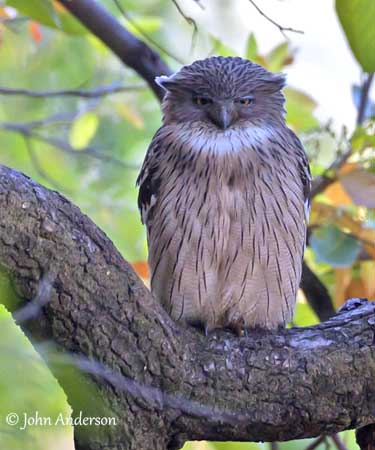
Text by Nicole Bouglouan
Photographers:
John Anderson
John Anderson Photo Galleries
Aurélien Audevard
OUESSANT DIGISCOPING
Ken Havard
My Bird Gallery & Flickr gallery 1 & Flickr gallery 2
Sources:
HANDBOOK OF THE BIRDS OF THE WORLD Vol 5 by Josep del Hoyo-Andrew Elliott-Jordi Sargatal - Lynx Edicions - ISBN: 8487334253
A Field Guide to the Birds of South-East Asia by Craig Robson. New Holland Publishers. ISBN: 9781780090498
OWLS OF THE WORLD – By Claus König, Friedhelm Weick and Jan-Hendrik Becking - IBSN 978-0-7136-6548-2
L’ENCYCLOPEDIE MONDIALE DES OISEAUX - Dr Christopher M. Perrins - BORDAS - ISBN: 2040185607
BirdLife International (BirdLife International)
CREAGUS@Monterey Bay (Don Roberson)
Imago Mundi – Encyclopédie gratuite
Fish-owls
Strigiformes Order – Strigidae Family
Blakiston’s Fish-Owl, Brown Fish-Owl, Tawny Fish-Owl, Buffy Fish-Owl
Within the Family Strigidae, the four fish-owls form a small, slightly different group. They are closely related to eagle-owls, but they show several different morphological features, well-adapted to their feeding behaviour.
They are living in dense forests near water or bordering lakes, streams and rivers where they can find their favourite aquatic preys.
The fish-owls are predatory birds. They rest during the day in dark places among the foliage of the trees. They emerge at dusk and hunt at night until dawn. Their cryptic plumage makes them almost invisible in the darkness.

The four species occur in Asian regions.
The three owls of genus Ketupa are found in Asia in tropical latitudes. The Tawny Fish-Owl and the Buffy Fish-Owl are very closely related and they occupy adjoining ranges in and near SE Asia.
The Brown Fish-Owl has wider range which includes some parts of the distribution of the two previous species.
The Blakiston’s Fish-Owl occurs in eastern Asia, including Siberia, NE China and Hokkaido, Kuril and Sakhalin Islands. This species is very similar to the Eurasian Eagle-owl (Bubo bubo).
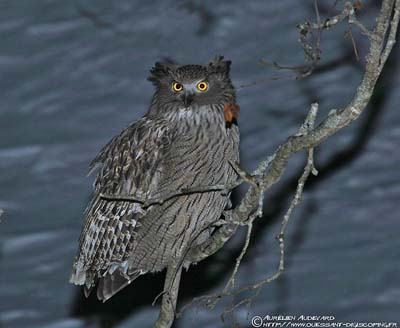
The fish-owls differ from the eagle-owls in having some physical features related to their behaviour.
As they feed primarily on fish and crustaceans, they have unfeathered tarsi and toes. The soles of the feet are covered with spiny scales to allow the bird a strong grip on slippery and slimy fish. The claws are also strongly curved.
However, the Blakiston’s Fish-Owl has feathered tarsi like all Strigidae, but it has bare toes. This species is living in areas where the winters are extremely cold with numerous frozen lakes and rivers. These feathers are a good protection against these harsh weather conditions.
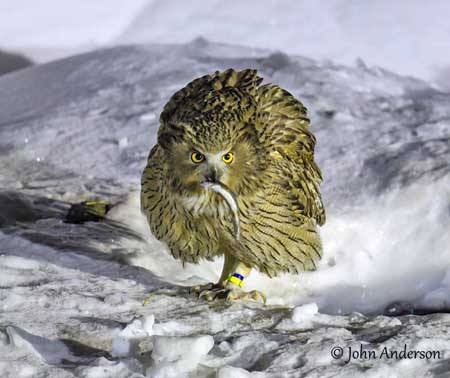
The four species have smaller facial disk than other owls. Facial disks and their distinctive feather structure help the owls to detect preys in darkness, even under the snow or thick leaf litter.
The fish-owls do not need such specialized tools. They often search for preys by wading in shallow water. They detect their victims mainly by sight, less often by sound. Their ear-tufts are usually floppy and directed sideward.
They also fish from a perch at water edge. Once the prey is seen, they swoop down and catch it with their well-adapted feet and claws. Numerous aquatic preys are caught just below the surface.

The Blakiston’s Fish-Owl may stand near holes in the ice. When some fish comes to the surface, it catches it with one foot before to take it with the bill. However, the fish-owls also take some terrestrial preys such as rats, mice, reptiles, occasionally bats, amphibians and large insects.
But the fish-owls also differ from the eagle-owls in lacking the comb-like fringes on the outer primary feathers, making their flight less silent than that of other owls. This particular feature suggests that the fish-owls have poorly developed ability to detect the preys by sounds, as they are themselves a bit noisy.
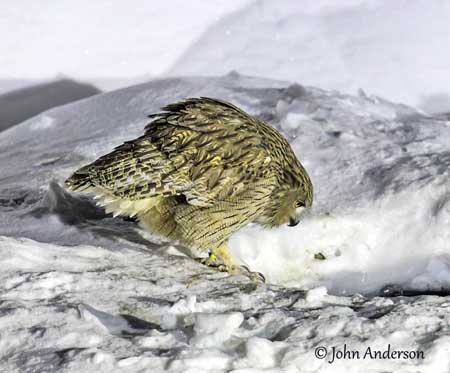
The fish-owls frequent dense forests near water. They usually prefer freshwater, but the Blakiston’s Fish-Owl also forages on rocky seacoasts and occurs mainly in lowlands, whereas the three Ketupa species can be seen from the plains up to 800, 1500 and 2400 metres of elevation depending on each species and its range.
The four fish-owls are resident. At the beginning of the breeding season, both mates frequently duet. The male initiates the duet and the female responds immediately. Other sounds are characteristic of the Strigidae with in addition, a range of hisses, mews, screams, shrieks and typical “whoo-hoo” calls.
They are monogamous with long-term pair-bonds. As resident species, they maintain and defend the territory all year round. The fish-owls are very territorial.
The male sings to attract females, but also to renew the pair-bond with its mate, and to strengthen them. Courtship feeding is part of displays, and often occurs prior to copulation. Other typical displays are probably performed, but more information is needed.
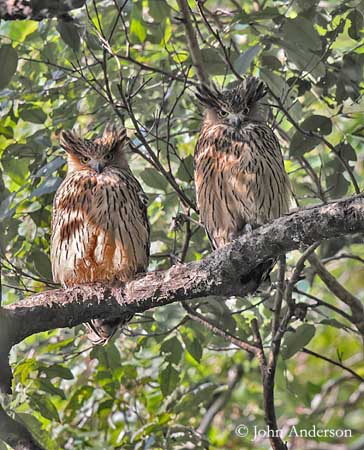
The fish-owls do not build their own nest. They may use abandoned raptor’s nests, and often large hollows in trees, or they nests on rocky ledges in steep river bank. The nests can be placed between 3 and 21 metres above the ground according to the site.
The clutch contains 1-3 white eggs, and the female incubates alone. The incubation varies from 35-37 days to 28-29 days depending on the species. She is fed by the male during this period and then, after the hatching, the male provides food to female and young. Usually, only one chick survives. The juvenile fledges 40-50 days after hatching, but it is still fed by both parents for some weeks or months.
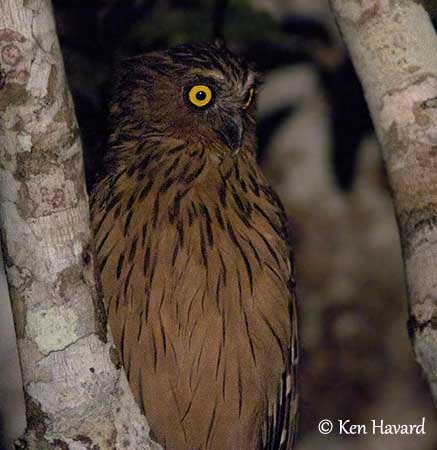
The Blakiston’s Fish-Owl is classified as Endangered due to human’s activities including destruction of native forest, human disturbances, persecution and competition for food with commercial over-fishing. The population is declining and placed in the band 1,000/2,499 mature individuals, probably about 2,000 birds.
The Brown Fish-Owl is evaluated as least Concern in spite of some extinct populations in Middle-east.
The Tawny Fish-Owl is also evaluated as Least Concern with stable populations, but it is threatened by habitat loss with destruction of forests, and persecution.
The Buffy Fish-Owl is sometimes persecuted at fish-ponds by local fishers. Its population is suggested to be stable and the species is evaluated as Least Concern.
In spite of some morphological differences, the fish-owls belong to the family Strigidae, a family that includes amazing, smart, stunning birds. We must protect them because the forests need their typical calls at night!
